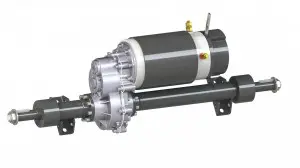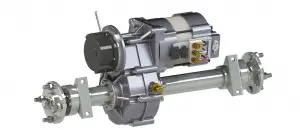As the global shift to electrification accelerates, electric transaxles have become the “heart” of electric vehicles (EVs), industrial machinery, and off-highway equipment. For buyers navigating the market, two primary options dominate: DC (Direct Current) series and AC (Alternating Current) series electric transaxles. While both serve the same core purpose—transmitting power from the motor to the wheels—their design, performance, and application suitability vary drastically. This guide breaks down their critical differences to help you make an informed decision for your export projects.
1. Fundamental Working Principle: The Core Distinction
The biggest divide between DC and AC electric transaxles lies in how their motors convert electrical energy to mechanical energy.
DC Series Electric Transaxle
- Motor Design: Relies on a DC motor with a commutator (a rotating electrical switch) and brushes (carbon contacts). These components work together to reverse the current direction in the motor’s armature (rotating part) at precise intervals, ensuring continuous rotation.
- Power Supply: Requires a direct current source (e.g., lead-acid batteries, lithium-ion batteries with simple voltage regulation). The transaxle’s speed is controlled by adjusting the voltage supplied to the motor (via potentiometers or basic controllers).
- Mechanical Limitation: The commutator and brushes are physical, moving parts—this creates friction, generates heat, and limits long-term durability.
AC Series Electric Transaxle
- Motor Design: Uses an AC motor (typically synchronous or asynchronous) with no commutator or brushes (brushless design). Instead, an inverter converts DC power from the battery to alternating current, which alternates the magnetic field in the motor’s stator (fixed part) to spin the rotor.
- Power Supply: Still works with DC batteries, but the inverter adds a critical layer of control. Speed and torque are adjusted by modifying the frequency and voltage of the AC current (vector control or PWM technology).
- Mechanical Advantage: No moving contact parts eliminate friction and wear, resulting in smoother operation and longer lifespans.
2. Performance Metrics: Speed, Torque, and Efficiency
Performance is make-or-break for electric transaxles, especially in industrial or automotive applications. Here’s how DC and AC series stack up:
|
Metric
|
DC Series Electric Transaxle
|
AC Series Electric Transaxle
|
|
Speed Range
|
Narrower. Optimal for low-to-moderate speeds (up to 500 RPM for most industrial models). High speeds cause excessive brush wear and overheating.
|
Wider. Can handle high speeds (1,000+ RPM) without performance loss, thanks to inverter-controlled frequency. Ideal for EVs or machinery requiring variable speeds.
|
|
Torque Delivery
|
High starting torque (excellent for heavy loads at low speeds, e.g., small forklifts). Torque decreases as speed increases (poor high-speed load capacity).
|
Consistent torque across the speed range. Inverters enable “torque vectoring”—adjusting torque to individual wheels for better traction (critical for off-highway equipment or EVs on rough terrain).
|
|
Energy Efficiency
|
Lower (65-80%). Energy is lost to brush friction, heat, and commutator resistance. Battery life is shorter in continuous use.
|
Higher (85-95%). No brush friction; inverter technology optimizes power usage. Extends battery life by 15-20% compared to DC models in equivalent applications.
|
|
Temperature Resistance
|
Poor. Brushes generate heat, limiting operation in high-temperature environments (e.g., desert regions or factory floors).
|
Excellent. Brushless design and advanced cooling systems (liquid or air) allow operation in -40°C to 85°C conditions—ideal for global exports to diverse climates.
|
3. Application Suitability: Which Fits Your Use Case?
Choosing between DC and AC depends entirely on your target market’s application. Here’s a breakdown of their ideal use cases:
DC Series: Best for Low-Demand, Cost-Sensitive Applications
DC transaxles excel in scenarios where speed and durability are secondary to upfront cost and simple operation. Common export applications include:
- Small electric vehicles: Golf carts, neighborhood electric vehicles (NEVs), and low-speed utility carts (e.g., resort shuttles).
- Light industrial equipment: Small pallet jacks, warehouse trolleys, and residential snow blowers.
- Emerging markets: Areas with limited access to advanced maintenance facilities (DC systems are easier to repair with basic tools).
Why? Their simple design, low upfront cost, and compatibility with affordable lead-acid batteries make them accessible for price-sensitive buyers.
AC Series: Ideal for High-Demand, High-Performance Applications
AC transaxles are the top choice for applications requiring reliability, efficiency, and advanced functionality. Key export use cases:
- Electric passenger/cargo vehicles: EVs, delivery vans, and buses (need high speed, long battery life, and torque for hills).
- Heavy industrial machinery: Large forklifts, construction equipment (e.g., electric excavators), and agricultural vehicles (traction for rough terrain).
- Off-highway equipment: Mining carts, airport ground support vehicles, and marine EVs (demanding environments require durable, low-maintenance systems).
Why? Their brushless design reduces downtime, high efficiency cuts operating costs, and inverter control enables integration with smart systems (e.g., telematics for fleet management)—a major plus for industrial buyers in developed markets.
4. Total Cost of Ownership (TCO): Beyond Upfront Price
For export buyers, TCO (upfront cost + maintenance + energy costs) is more critical than initial price. Here’s the comparison:
DC Series: Low Upfront Cost, Higher Long-Term Expenses
- Upfront Cost: 30-50% lower than AC models (e.g., a 5kW DC transaxle costs
800−
1,200, vs.
1,500−2,500 for an equivalent AC unit).
- Maintenance Costs: High. Brushes need replacement every 500-1,000 operating hours (
50−
100 per service). Commutators require cleaning or repair annually.
- Energy Costs: Higher. Lower efficiency means more frequent battery charging or replacement (lead-acid batteries last 1-2 years in DC systems).
TCO Verdict: Affordable for short-term or low-use applications, but expensive over 3+ years.
AC Series: Higher Upfront Cost, Lower Long-Term Expenses
- Upfront Cost: Higher, but offset by long-term savings.
- Maintenance Costs: Low. No brushes or commutators to replace—service intervals are 3,000+ operating hours. Most AC transaxles come with 5-year warranties (vs. 2-3 years for DC).
- Energy Costs: Lower. Higher efficiency reduces battery usage by 15-20%. Lithium-ion batteries (common with AC systems) last 3-5 years.
TCO Verdict: More cost-effective for high-use applications (e.g., daily industrial operations). Over 5 years, AC transaxles can save buyers 20-30% in total costs.
5. Key Considerations for Export Buyers
When selling to global markets, keep these regional and technical factors in mind:
- Voltage Compatibility: DC transaxles often use 12V/24V systems (common in small equipment), while AC systems use 48V/72V/96V (standard for EVs and heavy machinery). Ensure compatibility with local battery standards.
- Regulatory Compliance: AC transaxles are easier to meet strict emissions and efficiency standards (e.g., EU’s CE, US’s EPA, China’s CCC) due to their low energy loss.
- Maintenance Access: In regions with limited technical expertise, DC systems may be preferred (simpler to repair). For developed markets, AC’s low maintenance is a key selling point.
Final Decision Guide: DC or AC?
Use this checklist to recommend the right transaxle for your customers:
|
Choose DC Series If:
|
Choose AC Series If:
|
|
Application requires low speed (<500 RPM)
|
Application needs high speed or variable speeds
|
|
Budget is tight, and use is low-frequency
|
Long-term TCO is a priority
|
|
Maintenance access is limited
|
Equipment operates in harsh environments
|
|
Vehicle/machinery is small or light-duty
|
Vehicle/machinery is heavy-duty or high-performance
|
Conclusion
DC and AC electric transaxles are not “better” or “worse”—they are designed for different needs. DC series is the practical choice for cost-sensitive, low-demand applications, while AC series is the investment for high-performance, long-term reliability. As an exporter, understanding these differences lets you tailor solutions to your customers’ unique markets—whether that’s affordable golf carts for Southeast Asia or durable EV transaxles for European fleets.
Post time: Oct-15-2025



